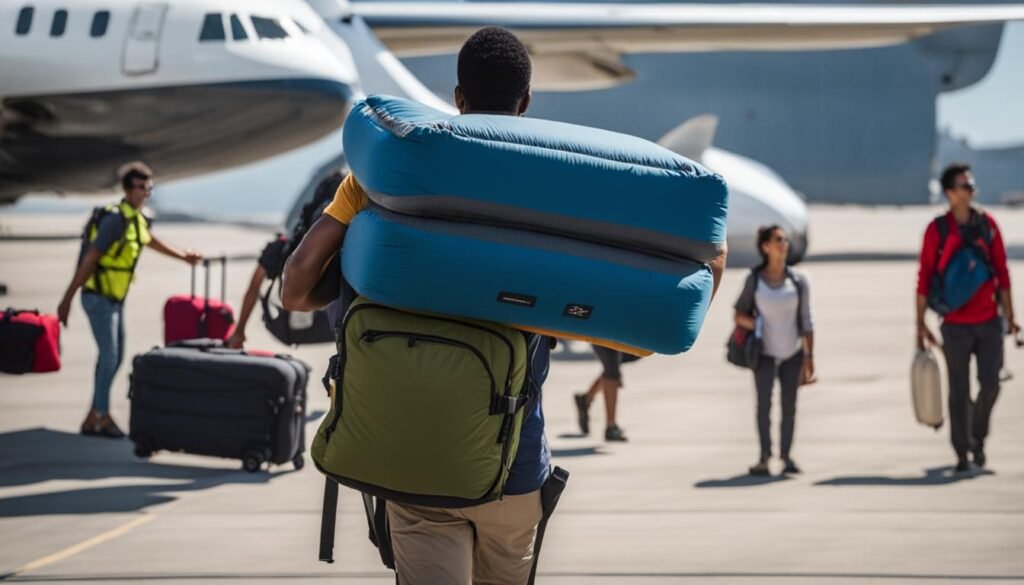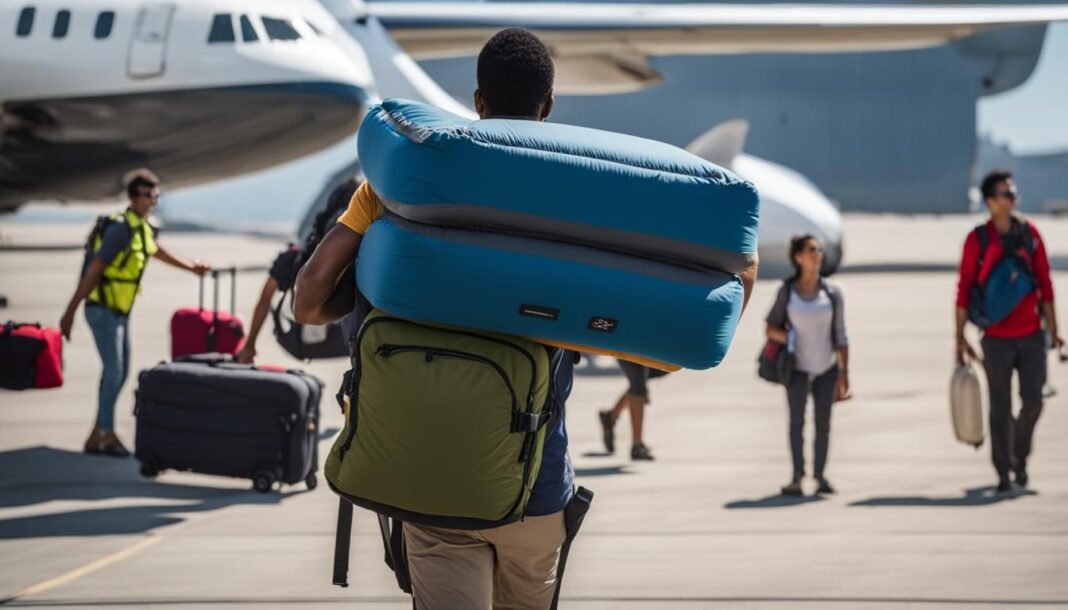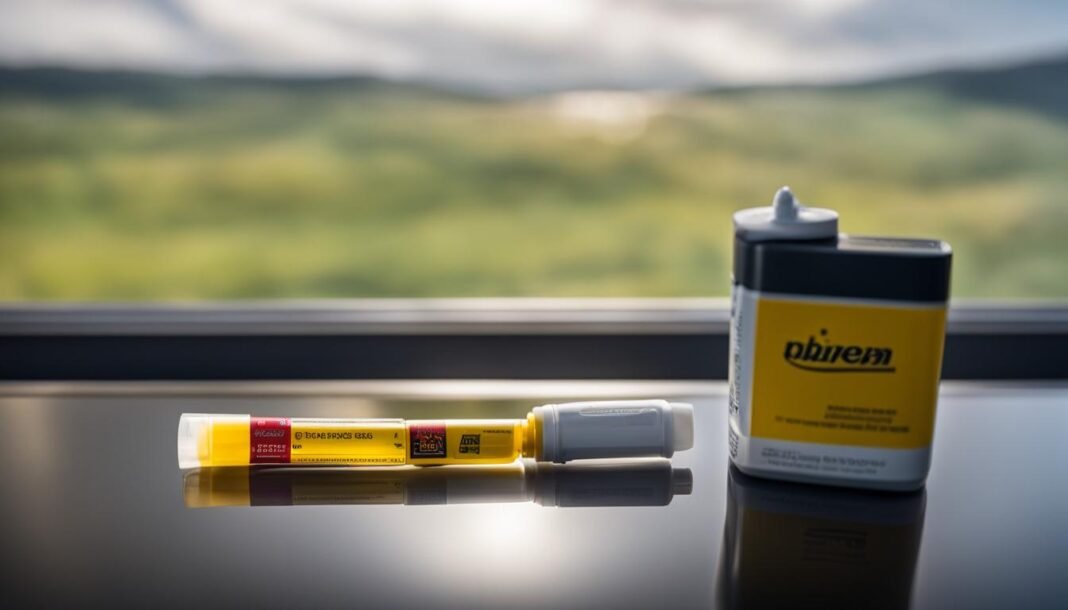According to TSA guidelines, you can bring an air mattress on a plane, whether it’s deflated or with a built-in pump. Air mattresses offer comfort, and convenience, and can help with allergies by providing a barrier between you and allergens on the ground.
When traveling with an air mattress, it’s important to choose the right size for your trip and pack it properly to ensure hassle-free travel. Having a backup inflation plan, such as an air pump, is also recommended.
Table of Contents

Quick Answer
Can You Bring an Air Mattress on a Plane?
Yes, air mattresses are allowed on every flight regardless of their form or shape.
Key Takeaways:
- You can bring an air mattress on a plane according to TSA guidelines.
- Air mattresses offer comfort and can help with allergies by providing a barrier from allergens on the ground.
- Choose the right size and pack the air mattress properly for hassle-free travel.
- Consider having an air pump as a backup inflation plan.
- Check with your airline for any size or weight restrictions when packing an air mattress in your carry-on bag.
Advantages of Traveling with an Air Mattress

Traveling with an air mattress offers numerous benefits for both indoor and outdoor adventures. Whether you’re exploring a new city or embarking on a camping trip, having an air mattress in your travel arsenal can enhance your overall comfort and convenience.
One of the primary advantages of traveling with an air mattress is the comfort and support it provides for a restful night’s sleep. Unlike traditional sleeping arrangements, air mattresses allow you to personalize your sleeping surface by adjusting the firmness to your liking. This ensures that you wake up feeling refreshed and ready to take on the day.
In addition to comfort, air mattresses are extremely portable and easy to set up. They are designed to be compact and lightweight, making them an ideal travel companion. Whether you’re staying in a hotel, visiting friends or family, or camping in the great outdoors, you can quickly inflate and deflate your air mattress, saving you time and effort during your travels.
Another advantage of traveling with an air mattress is its ability to act as a barrier against allergens on the ground. Many people suffer from allergies, and sleeping on an air mattress can help alleviate symptoms by providing a barrier between you and potential irritants such as dust mites or pet dander.
When packing an air mattress for your flight, it’s essential to consider the size and height that best suits your needs. Opting for a compact fold and investing in a quality carrying case or bag will ensure effortless storage and transportation. Additionally, be mindful of any weight or size restrictions imposed by your airline to avoid any inconvenience or extra charges.
To summarize, the advantages of traveling with an air mattress are many. From comfort and portability to allergen protection, an air mattress enhances your travel experience. So whether you’re embarking on a solo adventure or planning a family trip, consider packing an air mattress to enjoy a good night’s sleep no matter where you go.
Guidelines for Bringing an Air Mattress on a Plane

When traveling with an air mattress, it’s important to be aware of the guidelines and regulations set by the Transportation Security Administration (TSA) and your airline. Here are some key considerations to keep in mind:
Carry-on vs. Checked Baggage
The TSA allows air mattresses to be packed in both carry-on and checked baggage. However, it’s essential to note that additional fees may apply for checked bags compared to flying with only carry-on luggage.
Size and Weight Restrictions
When packing an air mattress in your carry-on bag, it’s crucial to check with your airline for any size or weight restrictions. Some low-cost airlines may only allow one small personal item for free, making it challenging to find space for an air mattress. However, if your airline permits two items of hand luggage, you can consider packing the deflated air mattress in a carrying case or small duffle bag as your item.
It’s also crucial to be mindful of the size limitations for carry-on baggage, as well as weight limits for international flights. Ensure your air mattress adheres to these restrictions to avoid any issues during the security check process.
TSA and Airline-Specific Rules
While the TSA permits air mattresses in carry-on and checked bags, it’s always a good idea to check with both the TSA and your airline for specific rules and regulations regarding air mattress travel. These rules may vary depending on the airline, so it’s essential to familiarize yourself with any additional requirements before your trip.
Some airlines may have specific guidelines for carrying air mattresses with built-in pumps, or they may restrict certain types of air mattresses due to security concerns. By being informed about these rules in advance, you can ensure a smooth and hassle-free travel experience with your air mattress.
Table: Comparison of Air Mattress Travel Guidelines
| Carry-on Baggage | Checked Baggage | |
|---|---|---|
| Allowed | Yes | Yes |
| Additional Fees | No | May apply |
| Size Restrictions | Check with airline | Check with airline |
| Weight Restrictions | Check with airline | Check with airline |
The table provides a quick comparison of air mattress travel guidelines related to carry-on and checked baggage. However, it’s important to refer to your specific airline and the TSA for the most accurate and up-to-date information.
TSA Air Mattress Rules
The Transportation Security Administration (TSA) enforces strict regulations on items that can be brought on airplanes in the United States. When it comes to air mattresses, including those with built-in pumps, the TSA allows them to be packed in both checked baggage and carry-on bags.
However, it’s important to note that additional fees may apply for checked bags, so it’s advisable to check with your airline beforehand.
When traveling with an air mattress, it’s crucial to comply with the size and weight restrictions set by your airline. Deflating the air mattress and properly packing it in a carrying case or small bag is essential to ensure it meets the specified requirements.
While basic inflatable mattresses are generally allowed in carry-on bags, it’s important to be aware that those with metal frames or rails may not pass the TSA checkpoint due to security concerns.
To ensure a smooth travel experience, it’s always recommended to stay updated on the TSA guidelines and regulations regarding air mattress travel. Checking with both the TSA and your airline for specific rules and any updates beforehand can help you avoid any surprises or inconveniences at the security checkpoint.
Continue Reading:
- Can You Bring a Tripod on a Plane?
- Can You Bring a Tent on a Plane? Flying with Camping Gear
- Can You Bring a Screwdriver on a Plane?
- Can You Bring a PS5 on a Plane?
- Can You Bring a Pipe on a Plane?
- Can You Bring a Pencil Sharpener on a Plane?
- Can You Bring a Parachute on a Plane? Tips & Rules
- Can You Bring a Cigar Cutter on a Plane?
- Can You Bring a Camera on a Plane?
- Can You Bring a Blender on a Plane? Easy Travel Tips
Frequently Asked Questions
Can you bring an air mattress on a plane?
Yes, according to TSA guidelines, you can bring an air mattress on a plane, whether it’s deflated or with a built-in pump.
What are the advantages of traveling with an air mattress?
Traveling with an air mattress offers comfort, support for a restful night’s sleep, convenience, portability, and protection against allergens on the ground.
Are there any guidelines for bringing an air mattress on a plane?
When packing an air mattress, it’s important to choose the right size, pack it properly, and have a backup inflation plan, such as an air pump.
What are the TSA air mattress rules?
The TSA allows air mattresses to be packed in both carry-on and checked baggage, but it’s important to comply with size and weight restrictions set by your airline. It’s also important to check with the TSA and your airline for specific rules and regulations regarding air mattress travel.


